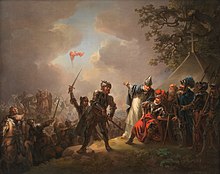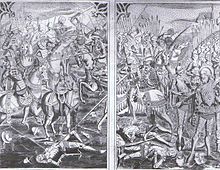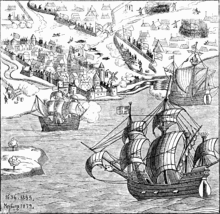
The Kalmar Union was a personal union in Scandinavia, agreed at Kalmar in Sweden as designed by widowed Queen Margaret of Norway and Sweden. From 1397 to 1523, it joined under a single monarch the three kingdoms of Denmark, Sweden, and Norway, together with Norway's overseas colonies.
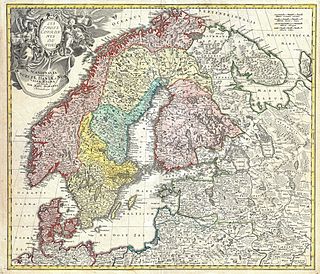
The history of Denmark as a unified kingdom began in the 8th century, but historic documents describe the geographic area and the people living there—the Danes—as early as 500 AD. These early documents include the writings of Jordanes and Procopius. With the Christianization of the Danes c. 960 AD, it is clear that there existed a kingship. Queen Margrethe II can trace her lineage back to the Viking kings Gorm the Old and Harald Bluetooth from this time, thus making the Monarchy of Denmark the oldest in Europe. The area now known as Denmark has a rich prehistory, having been populated by several prehistoric cultures and people for about 12,000 years, since the end of the last ice age.
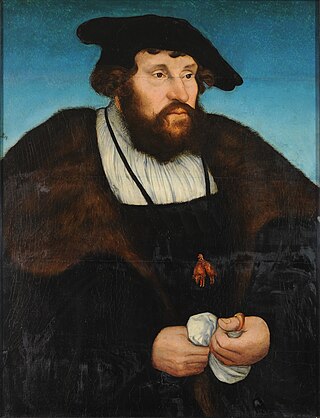
Christian II was a Scandinavian monarch under the Kalmar Union who reigned as King of Denmark and Norway, from 1513 until 1523, and Sweden from 1520 until 1521. From 1513 to 1523, he was concurrently Duke of Schleswig and Holstein in joint rule with his uncle Frederick.

John was a Scandinavian monarch under the Kalmar Union. He was king of Denmark (1481–1513), Norway (1483–1513) and as John II Sweden (1497–1501). From 1482 to 1513, he was concurrently duke of Schleswig and Holstein in joint rule with his brother Frederick.

The Early Vasa era is a period that in Swedish and Finnish history lasted between 1523–1611. It began with the reconquest of Stockholm by Gustav Vasa and his men from the Danes in 1523, which was triggered by the event known as the Stockholm Bloodbath in 1520, and then was followed up by Sweden's secession from the Kalmar Union, and continued with the reign of Gustav's sons Eric XIV, John III, John's son Sigismund, and finally Gustav's youngest son Charles IX. The era was followed by a period commonly referred to as the Swedish Empire, or Stormaktstiden in Swedish, which means "Era Of Great Power".

The Swedish War of Liberation, also known as Gustav Vasa's Rebellion and the Swedish War of Secession, was a significant historical event in Sweden, characterized by a nobleman named Gustav Vasa leading a rebellion and civil war against King Christian II. The war resulted in the deposition of King Christian II from the throne of Sweden, effectively putting an end to the Kalmar Union that had united Sweden, Norway, and Denmark. This conflict played a crucial role in shaping Sweden's national identity and history.

The Kalmar War (1611–1613) was a war between Denmark–Norway and Sweden. Though Denmark-Norway soon gained the upper hand, it was unable to defeat Sweden entirely. The Kalmar War was the last time Denmark-Norway successfully defended its dominium maris baltici against Sweden, and it also marked the increasing influence of the two countries on Baltic politics.
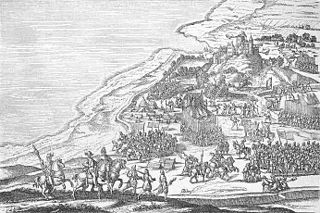
The Northern Seven Years' War was fought between the Kingdom of Sweden and a coalition of Denmark–Norway, Lübeck, and Poland–Lithuania between 1563 and 1570. The war was motivated by the dissatisfaction of King Frederick II of Denmark with the dissolution of the Kalmar Union, and the will of King Eric XIV of Sweden to break Denmark's dominating position. The fighting continued until both armies had been exhausted, and many men died. The resulting Treaty of Stettin was a stalemate, with neither party gaining any new territory.

The Torstenson War was fought between Sweden and Denmark–Norway from 1643 to 1645. The name derives from Swedish general Lennart Torstenson.

The Count's Feud, also called the Count's War, was a war of succession that raged in Denmark in 1534–36 and brought about the Reformation in Denmark. In the international context, it was part of the European wars of religion. The Count's Feud takes its name from the Protestant Count Christopher of Oldenburg, who supported the Catholic King Christian II, deposed in 1523, over the election of Christian III, a staunch Protestant who had already implemented Lutheranism as the state religion in Schleswig and Holstein in 1528.

The history of Scandinavia is the history of the geographical region of Scandinavia and its peoples. The region is located in Northern Europe, and consists of Denmark, Norway and Sweden. Finland and Iceland are at times, especially in English-speaking contexts, considered part of Scandinavia.

The Treaty of Stettin of 13 December 1570, ended the Northern Seven Years' War fought between Sweden and Denmark with its internally fragmented alliance of Lübeck and Poland. It also settled Swedish, Danish, and Holy Roman Imperial claims regarding the Livonian War. Unfavourable for Sweden, the treaty assured Danish hegemony in Northern Europe for a short period. Yet, because of its inconclusiveness, it did not prevent further warfare between Denmark-Norway and Sweden, which ended only in the 1720s.

The Dano-Swedish War of 1658–1660 was a war between Denmark–Norway and Sweden, with the former backed by the Dutch Republic and Poland. It is known in Denmark as the Second Karl Gustav War, in Norway as Bjelkes Feud in Sweden as Karl Gustav's Second Danish War, and in the Netherlands as the Swedish-Dutch War.

The relations between Denmark and Sweden span a long history of interaction. The inhabitants of each speak related North Germanic languages, which have a degree of mutual intelligibility. Both countries formed part of the Kalmar Union between 1397 and 1523, but there exists an inherited cultural competition between Sweden and Denmark. From 1448 to 1790 the two kingdoms went to war against each other at nearly every opportunity; in more than one case a new king tried to prove his worth by waging war on the other country for little or no political reason. Eleven Dano-Swedish wars took place between 1521 and 1814.

Denmark–Norway was an early modern multi-national and multi-lingual real union consisting of the Kingdom of Denmark, the Kingdom of Norway, the Duchy of Schleswig, and the Duchy of Holstein. The state also claimed sovereignty over three historical peoples: Frisians, Gutes and Wends. Denmark–Norway had several colonies, namely the Danish Gold Coast, the Nicobar Islands, Serampore, Tharangambadi, and the Danish West Indies. The union was also known as the Dano-Norwegian Realm, Twin Realms (Tvillingerigerne) or the Oldenburg Monarchy (Oldenburg-monarkiet).
The military history of Norway commences before the Viking Age with the internal wars fought between regional kings to obtain the supreme kingship of the whole of Norway. The most famous period of Norwegian history and thus military history is the Viking Age, but the early Middle Ages was the era when Norwegian military power in Europe reached its peak. Since then the Norwegian military has experienced long periods of neglect, but also rearmament and victories.

The Dano-Swedish War was the first conflict between Denmark and Sweden. The Danes invaded Sweden by sea, but were defeated early at the Battle of Brunkeberg, in which King Christian I of Denmark was wounded by a cannonball. The Danish invasion was repelled, and the Swedes were independent from the Kalmar Union.
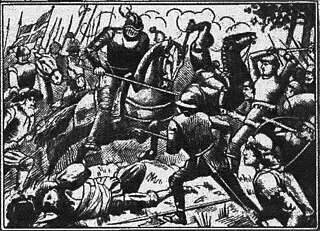
The Dano-Swedish War from 1501 to 1512 was a military conflict between Denmark and Sweden within the Kalmar Union.

The Dano-Hanseatic War, also known as the Kalmar War with the Hanseatic League, or the Danish-Hanseatic War of 1426-1435, was an armed trade conflict between the Danish-dominated Kalmar Union and the Hanseatic League led by the Free City of Lübeck.
Maerten Thijssen, died 1657, was a Dutch admiral who entered into Swedish service, becoming a Swedish admiral and a Swedish nobleman under the name Mårten Anckarhielm. He played an important role at the Battle of Fehmarn 1644.

